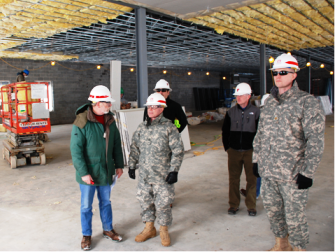(Originally posted March 14, 2008)
Guest Posting by MG Bo Temple
LTG Van Antwerp asked me to share my experiences from my visit to Japan last month. In February, I spent some time with District Engineer Colonel Barrett Holmes and his team.
I had the pleasure of joining the
Japan Engineer District at the annual Senior Engineer Conference, a joint forum sponsored by the District and the United States Forces Japan. At the conference, we discussed a variety of issues involving the current and future construction programs taking place throughout Japan. The event was a big success due to the hard work of people like Keily, known by most as “Snoopy.”
During my trip, I visited a number of the key projects sites on the main Japanese island of Honshu, including a wharf upgrade project at Yokosuka where the U.S. Navy will soon deploy the
USS George Washington and its crew. Our team is upgrading the berth itself, and building a high quality water facility, a new power station facility, and a series of utility tunnels that will connect the generation plant to the wharf upgrades. These projects wouldn’t be possible without the outstanding work of people like Arnold, the project engineer for the wharf upgrade, and Yoshio, the quality assurance representative and electrical engineer on the power upgrades.

A project briefing at the Iwakuni airstrip in Japan
From Yokosuka I traveled south to Iwakuni. The folks there are literally moving mountains. The Marine Corps requires a new runway, but the only way to expand the base is out into the water. So, Setsuharu, and others on the team there, are making land where there was none. Through exemplary technical and leadership skills they relocated more than 21 million cubic meters of earth from a nearby mountaintop to create 533 acres of new land for the new runway. Their close coordination with the Government of Japan, the U.S. Navy and the Marine Corps made this project happen.
My final stop was in Okinawa, where I visited the vast array of projects that our dedicated people are responsible for. Dawn, the Okinawa Area Engineer, and Dewai, the chief of Project Management Branch-Okinawa, have been instrumental in managing the diverse joint program throughout the island.
I visited a beautiful middle school that will be ready for students next year. I was truly impressed by the quality of construction that the Ryukyu resident engineer, Shigeru, and the rest of the team are delivering. These facilities are on par with the finest schools in any city in the United States – service members and their families who are considering an assignment in Okinawa can feel good about their quality of life.
In northern Okinawa, I visited a range construction program led by Norman. He and his crew are working hard to ensure our troops have quality facilities to hone their war-fighting skills. Given the rugged terrain, they are employing a number of creative ideas to achieve the desired training effect on each range.
I had a great visit with the Japan Engineer District team – they truly are providing quality projects for the Soldiers, Sailors, Airmen, Marines and their Families living and working in Japan.
Next time, I’ll tell you about my wild adventures going “north to Alaska!”
dcordell Corps Projects, Infrastructure, International and Interagency Services, Military Programs Honshu, Iwakuni, Japan, Japan Engineer District, Marine Corps, Okinawa, U.S. Navy, USS George Washington, Yokosuka



